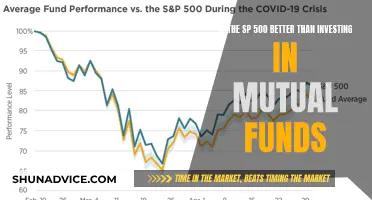
Investing in mutual funds is a great way to get exposure to the stock market and other types of asset classes. Mutual funds are a collection of investment assets packaged as a single investment, allowing investors to pool their money to invest in a diverse portfolio of stocks, bonds, or other assets.
1. Understand the difference between an actively managed vs. passively managed mutual fund. Actively managed funds are run by professionals aiming to beat the market, while passively managed funds (also known as index funds) aim to mimic the market.
2. Know the costs: Be aware of the expense ratio, which is the percentage of the fund's assets that go towards annual fees. Also, look out for sales commissions, known as loads, which are charged by some funds when buying or selling shares.
3. Decide on your investment goals and risk tolerance: Are you investing for the long term or short term? Do you want to focus on growth or income? This will help you determine the right mix of stocks, bonds, and other assets for your portfolio.
4. Choose a brokerage account: You can invest in mutual funds through an online brokerage account, which offers a wide range of funds from different companies. Alternatively, you can invest directly through the fund company, such as Vanguard or Fidelity.
5. Research and select mutual funds: Consider factors such as past performance, expense ratios, load fees, and management style (active vs. passive) when selecting specific funds to invest in.
6. Set up a plan to invest regularly: Decide how much you want to invest and how often. Consistent investing can help you benefit from dollar-cost averaging, reducing the impact of market volatility on your purchases.
7. Monitor and rebalance your portfolio: Keep an eye on your mutual funds and assess your portfolio periodically (annually or semi-annually) to ensure it still aligns with your investment goals and risk tolerance.
Remember, investing in mutual funds offers instant diversification, making it a great option for those who don't want to pick and choose individual investments. Always do your research and understand the fees and risks associated with any investment before committing your money.
| Characteristics | Values |
|---|---|
| Investment type | Stocks, Bonds, Commodities, Real estate |
| Investment vehicle | Mutual fund |
| Investment strategy | Active, Passive |
| Investment goals | Long-term, Mid-term, Near-term |
| Investment costs | Expense ratio, Load fees, Management fees, 12b-1 fees, Commissions |
| Investment account | Brokerage account, Demat account, Retirement account |
| Investment research | Fund prospectus, Fund performance, Fund ratings |
| Investment style | Value investing, Contrarian investing, Momentum investing |
What You'll Learn

Active vs. passive funds
One of the biggest distinctions between different mutual funds is whether they pursue an active or passive investment strategy. The difference will determine how the fund invests and can ultimately have a big impact on the returns you earn as an investor.
Active funds are managed by professional investors with the goal of outperforming a market index, such as the S&P 500 index. Active funds come with larger fees (often around 1% of the fund's assets) to pay for professional management.
Passive mutual funds, on the other hand, are managed to track the performance of a market index. They do not require an expensive investment team to manage the portfolio because they aren't trying to identify the best performers. This allows passive funds to charge very low fees and sometimes no fees at all, which leaves more of the return for the fund's investors.
Passive funds may sound simple, but they have consistently beaten actively managed funds over long time periods. Passive funds also allow for a more hands-off approach, which is rising in popularity.
However, active funds offer more flexibility and can be useful for investors who want to target specific areas they think are poised for growth. Active funds can also be useful for hedging and risk management.
In the end, the choice between active and passive funds depends on your investment goals, risk tolerance, and the amount of time and resources you are able to devote to researching and trading.
Vanguard Funds: Where to Invest and Why
You may want to see also

Expense ratio and other costs
When investing in mutual funds, it is important to consider the costs involved, as these will impact your overall returns. The expense ratio is a crucial factor to take into account, as it directly affects your investment profits. This ratio is the annual fee that you, as an investor, pay to cover the fund's operating expenses, such as management and marketing. It is calculated by dividing the fund's operating expenses by the total assets under management. The expense ratio is usually listed on the prospectus of the fund and on many financial websites.
The expense ratio is made up of three main fees. Firstly, there are management fees, which are paid to the fund's investment advisor for managing the portfolio. Secondly, there are administrative costs, which cover the fund's day-to-day operations outside of trading securities, such as record-keeping and customer service. Lastly, there are other operating expenses, which include auditing, legal, and trustee services, as well as 12b-1 fees for marketing and growing the fund's assets.
It's important to note that the expense ratio does not include sales loads or brokerage costs, which are additional fees that you may have to pay. A typical expense ratio for an actively managed fund is around 0.5% to 0.75%, while a ratio above 1.5% is generally considered high. Passive funds, on the other hand, have lower expense ratios, with an average of about 0.12%.
When investing in mutual funds, it's essential to be aware of other costs beyond the expense ratio. These include administrative fees in a 401(k) or other employer-provided retirement plans, mutual fund sales loads, and commissions on stock trades. If you're investing in exchange-traded funds (ETFs), you may also incur brokerage fees, although many brokers now offer commission-free ETFs.
When evaluating mutual funds, it's crucial to consider the fund's fees in conjunction with its performance and investment strategy. While lower fees are generally preferable, they should not be the sole criterion for selecting a fund. It's important to weigh the costs against the potential for returns and to consider your investment goals and risk tolerance.
Additionally, when comparing fees, make sure you're comparing similar types of funds with the same investment approach. Actively managed funds, for example, will generally have higher expense ratios than passively managed funds.
A Guide to Getting Started with Mutual Funds
You may want to see also

Investment types
There are several types of mutual funds to consider, each with its own advantages and risks. Here are some of the most common types:
- Bond Funds: These funds primarily invest in fixed-income securities, such as bonds, which provide regular interest payments to investors. Bond funds are considered relatively safe and stable, making them attractive to investors seeking lower-risk investment options.
- Stock Funds: Stock funds focus on investing in the shares of different companies and aim for long-term appreciation of the company's stock. Some stock funds specialise in large-cap, mid-cap, or small-cap stocks, with small-cap funds tending to have higher volatility than large-cap funds.
- Balanced Funds: These funds hold a mix of bonds and stocks, offering a more balanced approach to investing. The distribution between stocks and bonds can vary depending on the fund's strategy.
- Index Funds: Index funds aim to replicate the performance of a specific stock market index, such as the S&P 500. These funds are passively managed, meaning they have lower fees due to infrequent asset turnover. Index funds are suitable for investors who want to match the performance of a particular index without actively selecting stocks.
- Money Market Funds: These funds invest in high-quality, short-term debt instruments and are considered low-risk with moderate returns. Money market funds are suitable for investors seeking a slightly higher return than a regular savings account.
- Growth Funds: Growth funds focus on investing in companies with higher growth potential. These funds tend to be more aggressive and may carry more risk, but they also offer the potential for larger gains.
- Income Funds: Income funds, also known as dividend-bearing funds, invest in a variety of dividend-paying stocks and interest-bearing bonds. These funds are suitable for investors seeking regular income from their investments.
- Target-Date Funds: Target-date funds are designed for investors with specific time horizons in mind, such as retirement. The fund's asset allocation automatically adjusts over time to become more conservative as the target date approaches.
- Sector-Specific Funds: Some mutual funds focus on specific sectors or industries, such as technology, healthcare, or energy. These funds can be appealing to investors who believe in the long-term prospects of a particular sector.
- International Funds: International funds invest in companies based outside of the investor's domestic market, offering exposure to foreign markets and currencies. These funds can provide diversification benefits and the potential for higher returns but may also carry additional risks, including currency fluctuations.
A Beginner's Guide to Index Funds Investing in Dubai
You may want to see also

How much to invest
When it comes to investing in mutual funds, there are a few things to consider in determining how much to invest.
First, it's important to understand the different types of mutual funds available, such as stock funds, bond funds, money market funds, balanced funds, and target-date funds. Each type of fund has its own level of risk and potential return, so choosing the right type of fund for your investment goals is crucial.
Once you've decided on the type of fund you want to invest in, you need to consider your financial situation, including your annual income, net worth, liquid assets, and tax status. It's important to have enough liquid assets to cover your day-to-day living expenses, other obligations, and emergencies, in addition to the amount you plan to invest.
Next, you should determine your investment budget. Mutual funds typically have a minimum investment requirement, which can range from $100 to a few thousand dollars. Some funds may even have a $0 minimum, allowing you to invest as little as $1. It's important to choose an amount that you can comfortably invest while also taking into account the fees associated with the fund, such as expense ratios, sales loads, and early redemption fees.
Additionally, your time horizon, or how long you plan to invest for, will impact the amount you invest. If you're investing for the long term, you may be able to invest a larger amount, as you have more time to ride out any market fluctuations. On the other hand, if you need the money in the short term, you may want to invest a smaller amount to reduce your risk.
Finally, consider your risk tolerance and investment objectives. If you have a higher risk tolerance, you may be comfortable investing a larger amount, while those with a lower risk tolerance may want to start with a smaller investment.
By carefully considering these factors, you can determine how much to invest in mutual funds in a way that aligns with your financial goals and comfort level.
How Fed Funds Rate Cuts Impact Investment Decisions
You may want to see also

Where to buy
Mutual funds are a great way to invest in a diversified portfolio of stocks and bonds, and you can buy them in several ways.
You can buy mutual funds directly from the mutual fund company, which can save you money on transaction fees, especially if you're making frequent and regular investments.
You can also buy mutual funds without a broker, either directly from the company or through a directory service such as The Moneypaper's Directinvesting.com.
If you're looking for a more hands-off approach, you can hire a financial advisor to help you with your finances and investment decisions.
Emerging Market Funds: Where to Invest and How
You may want to see also
Frequently asked questions
A mutual fund is a collection of investment assets packaged as a single investment. Mutual funds allow investors to pool their money to invest in a diverse portfolio of stocks, bonds, or other assets. They can be a great way to get exposure to the stock market and other types of asset classes.
You can buy mutual funds through online brokers or through the fund manager themselves. You will need to open an investment account, such as an IRA or a taxable brokerage account.
Mutual funds have different types of fees, including management fees, 12b-1 fees, and load fees. Management fees pay for the fund’s managers and investment advisors, while 12b-1 fees cover the costs of marketing and selling the fund. Load fees are similar to commissions and are charged by some funds when buying or selling shares in the fund.







